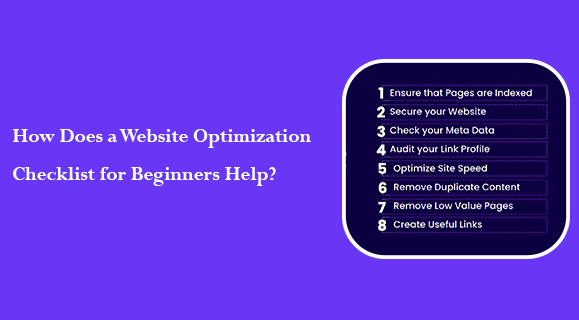Let’s face it, getting your website to perform like a rockstar doesn’t happen by accident. One minute you think everything’s running smoothly, and the next, Google buries your site six pages deep. Yikes.
That’s where a website optimization checklist for beginners steps in like your personal digital fairy godparent. It simplifies the techy stuff, keeps you from getting overwhelmed, and helps you build a website that loads fast, ranks high, and keeps visitors coming back for more.
So, if you’re wondering how this magical checklist actually helps, grab your coffee (or matcha, we don’t judge), and let’s dig in!
Streamlines the Chaos: The Beauty of a Checklist
Ever tried optimizing your website without a roadmap? It’s like assembling IKEA furniture blindfolded with lots of effort, not a lot of success.
A website optimization checklist gives you a clear path, helping you:
- Prioritize what matters (hello, page speed!)
- Avoid rookie SEO mistakes
- Track what’s done and what still needs tweaking
With everything laid out step-by-step, you’re not just randomly poking at things you’re making smart, strategic moves.
Speeds Up Your Site (Because Nobody Likes to Wait)
Let’s be real: if your site takes forever to load, your visitors are out faster than you can say “bounce rate.”
Here’s what the checklist nudges you to tackle:
- Compress images without killing quality
- Minimize code (HTML, CSS, JavaScript)
- Enable browser caching
- Use a fast, reliable hosting provider
These small changes can improve your website performance. Next thing you know, your website’s loading like lightning and Google loves that.
Makes Your Content Shine for SEO
You could write the next Hemingway-worthy blog, but if it’s not optimized for search? Crickets.
That’s why a website optimization checklist includes SEO must-dos like:
- Crafting compelling meta titles & descriptions
- Using keywords naturally (no stuffing, please)
- Structuring content with headings (H1s, H2s, H3s…)
- Adding alt text to all your images
The result: Search engines can actually find your content and so can your audience.
Keeps Your Website Mobile-Friendly
You’ve probably heard it before, but it bears repeating: if your site isn’t mobile-friendly, you’re losing visitors.
Luckily, your beginner’s checklist doesn’t leave you hanging. It’ll remind you to:
- Use a responsive design
- Optimize touch elements (like buttons!)
- Test across different devices and screen sizes
Because honestly, what good is a gorgeous desktop site if it turns into a hot mess on a smartphone?
Helps You Build Trust and Accessibility
Ever land on a site and immediately bounce because it looks sketchy or breaks your screen reader? Yeah, we’ve all been there.
A great website optimization checklist for beginners makes sure you’re:
- Using SSL certificates for a secure HTTPS site
- Creating clear, intuitive navigation
- Adding alt text and using proper contrast for accessibility
- Avoiding annoying pop-ups and autoplay videos (seriously, stop that)
When users feel safe and seen, they stick around. Simple as that.
Encourages Regular Tune-Ups (Because the Web Never Sleeps)
Here’s the deal: your website isn’t a “set it and forget it” kinda thing. It needs regular love.
That’s where this checklist truly shines. It helps you:
- Run regular performance audits
- Update old content and fix broken links
- Keep plugins and themes updated
- Track traffic and behavior through tools like Google Analytics
By doing a little maintenance here and there, your site stays in tip-top shape and ready for whatever algorithm update comes your way.
FAQs
What is a website optimization checklist for beginners?
It’s a step-by-step guide that helps newbies improve website performance, SEO, speed, and user experience without needing expert-level skills.
Why is it important to use a checklist for optimization?
It keeps you organized, prevents common mistakes, and ensures you’re covering all essential areas like speed, SEO, and mobile-friendliness.
Can I use the same checklist for every type of website?
Mostly yes! While some tweaks may be needed based on your platform (like WordPress vs Shopify), the fundamentals are pretty universal.
How often should I review my website with the checklist?
Ideally every few months. Quarterly tune-ups help catch issues early and keep your site running smoothly.
Do I need technical skills to follow the checklist?
Not necessarily. Many steps are beginner-friendly, and for the trickier stuff, there are plenty of tools or plugins that make it easier.
Will following the checklist improve my Google ranking?
It sure helps! By improving speed, SEO, and user experience, you’re giving your site a much better shot at climbing the search engine ladder.
Final Thoughts: Don’t Build Blind
If you’re just starting out, navigating the world of website optimization can feel like walking through a maze in the dark. But with a website optimization checklist for beginners, you’ve got a flashlight and a map powered by tools like core web vitals, schema markup, and responsive design frameworks.
It saves time, keeps you on track, and helps you build a site that’s not only beautiful but also fast, functional, and findable. So don’t wait until your bounce rate skyrockets or your rankings nosedive, get your checklist, roll up your sleeves, and start optimizing like a pro.

Leave a Reply